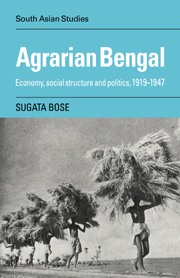Book contents
- Frontmatter
- Contents
- List of maps
- Preface
- List of abbreviations
- PART I AGRARIAN ECONOMY AND SOCIETY: STRUCTURE AND TRENDS
- 1 Introduction: A typology of agrarian social structure in early twentieth-century Bengal
- 2 Subsistence and the market I
- 3 Subsistence and the market II: The peasants' produce
- 4 The peasantry in debt: The working and rupture of systems of rural credit relations
- 5 Peasants into proletarians? The market in land and the question of change in the social organisation of production
- PART II PEASANTS AND POLITICS
- Conclusion
- Glossary
- Select bibliography
- Index
1 - Introduction: A typology of agrarian social structure in early twentieth-century Bengal
from PART I - AGRARIAN ECONOMY AND SOCIETY: STRUCTURE AND TRENDS
Published online by Cambridge University Press: 24 October 2009
- Frontmatter
- Contents
- List of maps
- Preface
- List of abbreviations
- PART I AGRARIAN ECONOMY AND SOCIETY: STRUCTURE AND TRENDS
- 1 Introduction: A typology of agrarian social structure in early twentieth-century Bengal
- 2 Subsistence and the market I
- 3 Subsistence and the market II: The peasants' produce
- 4 The peasantry in debt: The working and rupture of systems of rural credit relations
- 5 Peasants into proletarians? The market in land and the question of change in the social organisation of production
- PART II PEASANTS AND POLITICS
- Conclusion
- Glossary
- Select bibliography
- Index
Summary
The close intermeshing of revenue-collection structures with land tenures in the pre-colonial agrarian order brought the British face to face with the question of the basic tenure of land during their efforts to set up effective land revenue systems in India. The answer to this question, they reckoned, would help determine the point on the tenurial scale at which a private property right should be lodged: This ‘modern’ form of proprietary right was to be attached not to the land itself but to its revenues; the existence of a distinct customary right of physical dominion over the soil was never denied. An implicit, though not perfectly clear intention of British revenue law was, if possible, ‘to weld the novel property attaching to the revenue-collecting right to this primary right of dominion’. The Permanent Settlement of the land revenue in 1793 with the zamindars of Bengal accorded the property right to a class of people whose role in rural society as territorial magnates and tax-farmers had been to collect revenue and remit it to government, not to hold or exploit land as such. The discrepancy between colonial revenue law infused with its particular concept of property and the manner in which land was actually held and operated in Bengal ensured from the very outset that the legal classification of agrarian society was far removed from its working structure.
- Type
- Chapter
- Information
- Agrarian BengalEconomy, Social Structure and Politics, 1919-1947, pp. 3 - 33Publisher: Cambridge University PressPrint publication year: 1987



